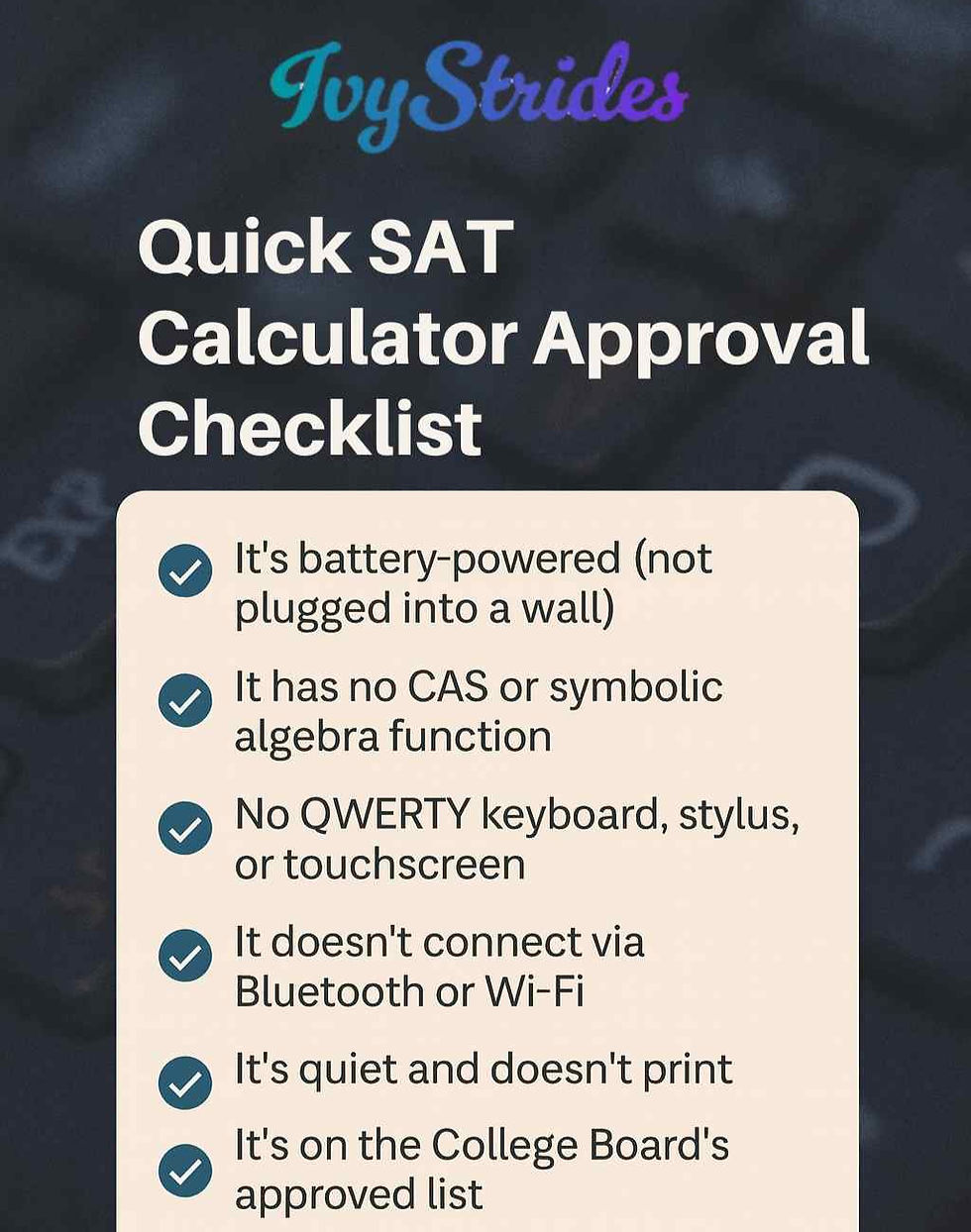What Calculators Are Allowed on the Digital SAT and What Are Not
- Hemant Attray
- 3 days ago
- 6 min read

At IvyStrides, we spend a lot of time with students who ask thoughtful questions. One that comes up often is “Which calculators can I actually use on the SAT now that it’s digital?”
It’s a fair question. The format has changed. The rules? Not everyone is sure. And if you bring the wrong calculator, you won’t just lose time, you might lose your edge.
The question isn’t about carrying a fancy device. It’s about showing up with the right tools, the kind that work for the Digital SAT and for the way you solve problems best. Some calculators are allowed and some aren’t, while others sit in a grey zone that’s often misunderstood.
We wrote this guide to help you clear all that up.
We’ll break down which calculators the College Board approves, which ones are banned (and why), how to check your model, and when to use the built-in calculator on the digital platform. Plus, we’ll show you how we at IvyStrides train students to use calculators the smart way, not just the allowed way.
If you’d like personal guidance, you can talk to our counselors today.
Understanding What Calculators Are Allowed on the Digital SAT
The SAT may be digital now, but calculators still play an essential role in your score. You’re allowed to use one during the Math section, and you actually have two options.
First, the Digital SAT includes a built-in, on-screen graphing calculator powered by Desmos. It’s available for every math question and is especially helpful if you’re comfortable with digital tools.
But many students still prefer using a physical calculator they know well. If you’re one of them, you’ll want to be sure the one you bring is permitted.
The College Board maintains a strict policy about which calculators are allowed. Specific models are banned, particularly those with CAS (Computer Algebra Systems), wireless functions, or advanced programming features. These restrictions apply to all test centers, whether you’re in Texas, Toronto, or Hyderabad.
What Calculators Are Approved and What Are Banned on the Digital SAT

Choosing the right calculator for the SAT isn't about which model looks high-tech. It's about whether your calculator follows the SAT calculator rules, and those come straight from the College Board.
You're allowed to use most scientific and graphing calculators, as long as they don’t have CAS, wireless features, or advanced programming. CAS (Computer Algebra System) is the main dealbreaker. It allows calculators to perform algebraic solving like factoring and symbolic manipulation, which isn’t permitted on the SAT.
Approved Calculator Types
Scientific calculators (like the TI-30XS or Casio fx-115ES Plus)
Graphing calculators without CAS (like the TI-84 Plus or Casio fx-9750GII)
Four-function calculators (allowed, but not recommended for test-day efficiency)
Calculators Not Allowed on the Digital SAT
Graphing calculators with CAS (e.g., TI-89, TI-Nspire CX CAS, HP Prime CAS)
Calculators with Bluetooth or infrared
Devices with QWERTY keyboards or styluses
Models that print, make sound, or need to be plugged in
Watch Out for These Common Calculator Mix-Ups
TI-Nspire CX = ✅ approved
TI-Nspire CX CAS = ❌ disqualified
Casio fx-991EX = ✅ safe
HP Prime CAS = ❌ not allowed
Understanding the SAT calculator policy ahead of time avoids surprises at check-in. We go over these models step by step in our Fall SAT batch, including hands-on usage so you're fully test-day compliant.
How to Check If Your Calculator Is Allowed on the SAT
Before test day, it’s essential to make sure your calculator is officially approved. While many popular models are allowed, some students bring calculators that seem fine but get flagged during check-in.
Here’s a simple checklist you can follow:
Quick SAT Calculator Approval Checklist

It’s battery-powered (not plugged into a wall)
It has no CAS or symbolic algebra function
No QWERTY keyboard, stylus, or touchscreen
It doesn’t connect via Bluetooth or Wi-Fi
It’s quiet and doesn’t print
It’s on the College Board's approved list
We also recommend bringing a backup calculator that’s been tested in your practice sessions, just in case something goes wrong on test day.
Best Calculators for the Digital SAT: What We Recommend
We recommend sticking with calculators that are both College Board-approved and familiar to you through regular practice.
If you're still deciding, here’s what to consider.
Top Recommended Calculator Models for the SAT
TI-84 Plus / TI-84 Plus CE
Graphing calculator, no CAS
Fast, intuitive, and highly popular among test-takers
Backlit screen (on CE model) helps with visibility
TI-30XS MultiView
Scientific calculator with key SAT functions
Lightweight, no distractions, suitable for students who don’t need graphing
Casio fx-9750GII
Budget-friendly graphing calculator
Simple interface, no CAS, and test-legal
Suitable for students used to Casio formatting
These calculators strike the right balance between functionality and familiarity, which matters more than tech specs on test day.
What Makes a Calculator “Best” for SAT?

Speed: Key functions are fast and accessible
No CAS: Compliant with SAT policy
Ease of use: You’ve practiced with it under test-like conditions
No learning curve: You don’t spend time figuring it out on exam day
During our SAT prep classes, we help students test different calculator models early in the prep journey. The goal isn’t just to find a legal calculator to use, but one that supports your pace, accuracy, and focus during the test.
How to Use Your Calculator Effectively During the SAT
The right calculator won’t guarantee a higher score, but the way you use it can. At IvyStrides, we remind students that a calculator is a tool for accuracy and speed, not a substitute for problem-solving.
Physical Calculator vs Built-In Tool
The Digital SAT provides a built-in Desmos graphing calculator for every math problem. It’s reliable and always available. Still, many students feel faster with a physical calculator they know well.
Built-in tool: Best for graphing or as a backup if your own device fails
Physical calculator: Ideal if you’ve practiced with it and can key in answers instinctively
In our SAT online classes, we train students on both so they can choose what feels most natural.
Smart Calculator Strategy
Solve simple questions without it, don’t waste time punching easy numbers
Use it to double-check trickier algebra or geometry
Learn built-in shortcuts for fractions, roots, and graphs
Practice under timed conditions to avoid over-reliance
Our students often discover that using the calculator strategically, not constantly, is what delivers a real score boost.
Digital SAT vs. ACT vs. PSAT: Calculator Policy Comparison
If you’re taking more than one college admissions test, it helps to know where the calculator rules overlap and where they don’t.
Here’s a clear side-by-side look:
Feature | Digital SAT | ACT | PSAT/NMSQT |
Calculator Section | Entire Math section | Entire Math section | Entire Math section |
Built-In Option | Yes – Desmos graphing calculator | No – must bring your own | Yes – Desmos graphing calculator |
Physical Calculator Allowed? | Yes, if approved | Yes, if approved | Yes, if approved |
CAS Calculators | Not allowed | Not allowed | Not allowed |
Wireless/Smart Devices | Not allowed | Not allowed | Not allowed |
Policy Source | College Board | ACT, Inc. | College Board |
What This Means for You
If you’re preparing for both the SAT and PSAT, the rules are identical—so the same calculator works.
The ACT follows nearly the same restrictions, but it doesn’t provide a built-in calculator. You must bring your own.
Choosing a calculator like the TI-84 Plus CE or Casio fx-9750GII ensures you’re covered across all three tests.
For detailed guidance, we’ve compiled easy-to-use charts and tips in our free SAT resources.
Your SAT Success Starts with the Right Tools
Choosing the right calculator is just one step toward feeling ready for the Digital SAT. What matters most is knowing how to use it with confidence and practicing under real exam conditions. That’s precisely what we do at IvyStrides.
In our programs, students learn with both the approved physical calculators and the built-in digital tool, so nothing feels new or uncertain on test day. We guide you on when to rely on your calculator, when to trust your math skills, and how to use both together for the best results.
If you’re ready to get started, sign up now and begin preparing with IvyStrides, the right way, with the right tools.
FAQs
Q1. Can I borrow or share a calculator during the SAT?
No. Sharing calculators during the test is not allowed. Each student must bring their own approved device.
Q2. What happens if my calculator stops working during the test?
You won’t be given a replacement at the center. That’s why we recommend bringing a backup calculator or extra batteries.
Q3. Is it okay to use a phone or tablet as a calculator?
No. Phones, tablets, smartwatches, and laptops are strictly prohibited. Only standalone calculators that meet College Board rules are allowed.
Q4. Do I need to reset or clear my calculator’s memory before the exam?
Not always, but test staff can ask you to clear stored programs or data. It’s best to reset your device before the test to avoid delays.
Q5. Are there size limits for calculators on the SAT?
There are no official size restrictions, but oversized calculators that are noisy, plug-in models, or print results are not permitted.
Q6. Can I use more than one calculator during the test?
Yes, you may bring more than one, as long as each is approved. Students often carry a primary calculator and a simpler backup.
Still have questions? Contact Us.




Comments